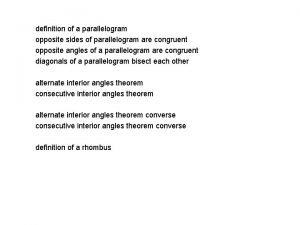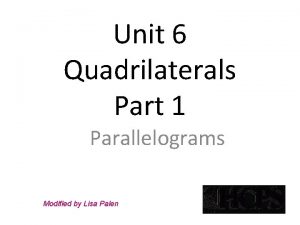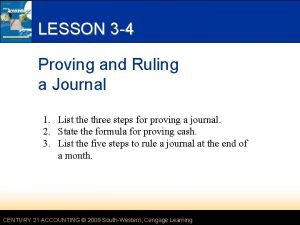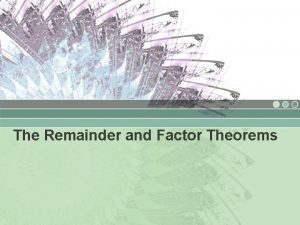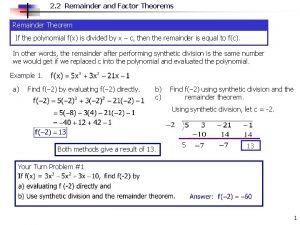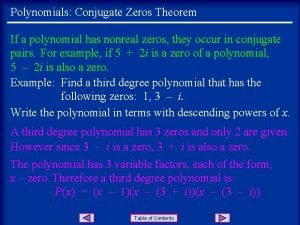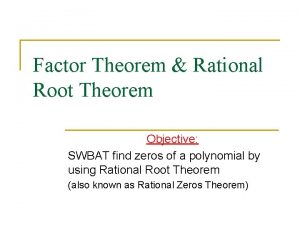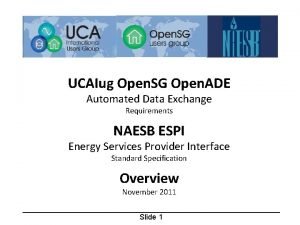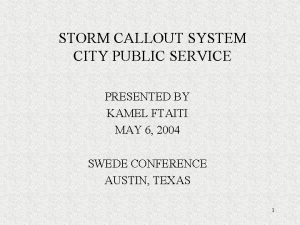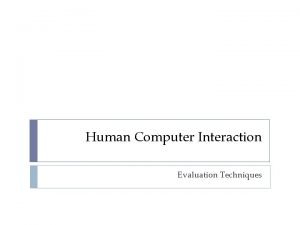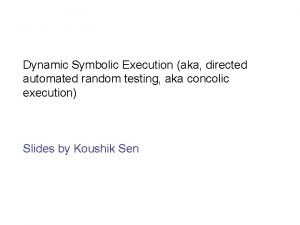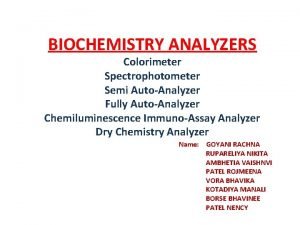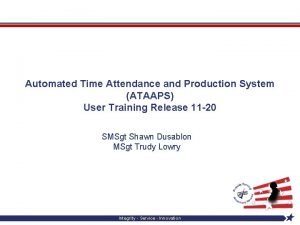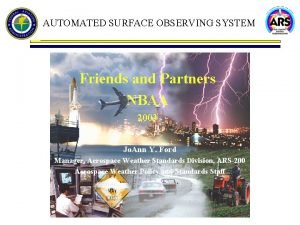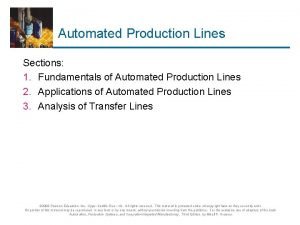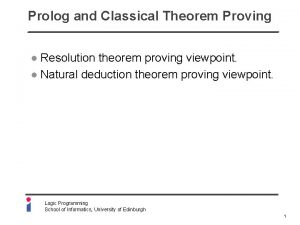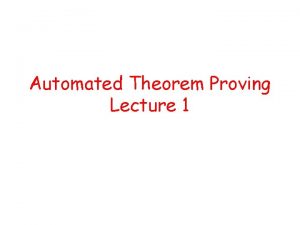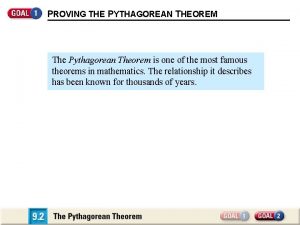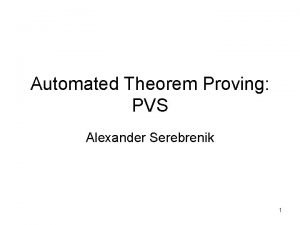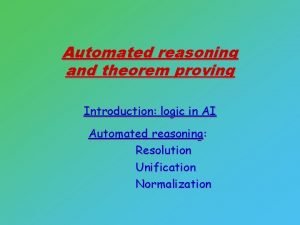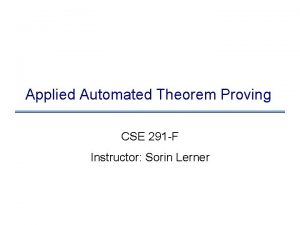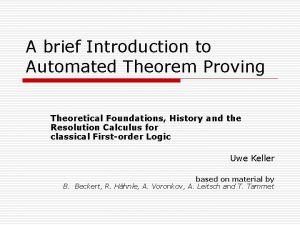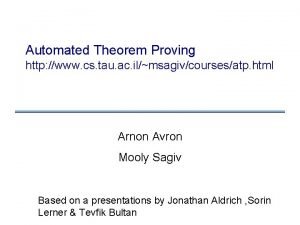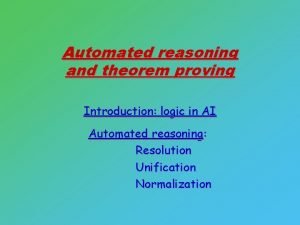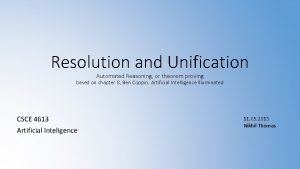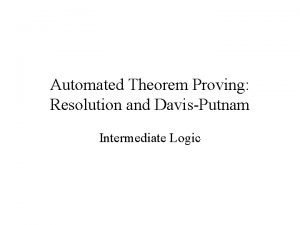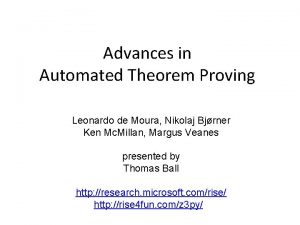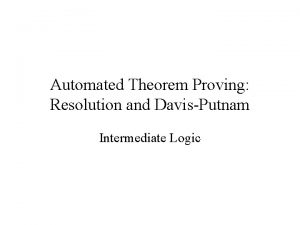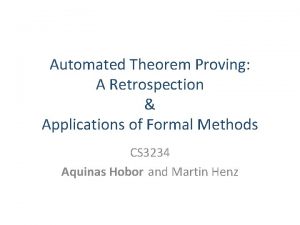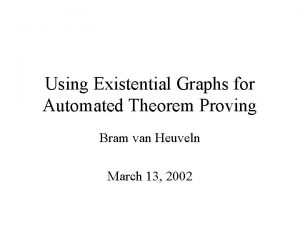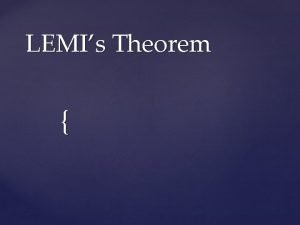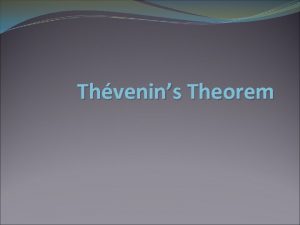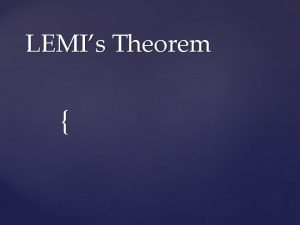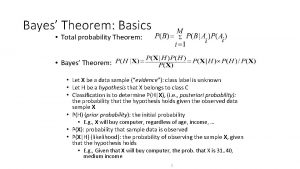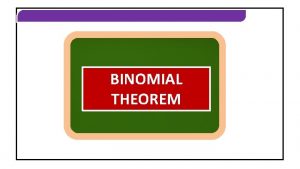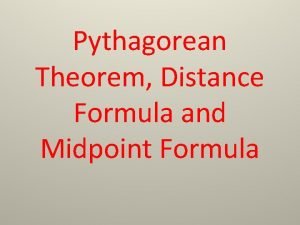Automated Theorem Proving Lecture 4 Formula A A


































- Slides: 34

Automated Theorem Proving Lecture 4

Formula : = A | | A Atom : = b | t = 0 | t < 0 | t 0 t Term : = c | x | t + t | t – t | ct | Select(m, t) m Mem. Term : = f | Update(m, t, t) f Field b Sym. Bool. Const x Sym. Int. Const c {…, -1, 0, 1, …}

Memory axiom for all objects o and o’, and memories m: o = o’ Select(Update(m, o, v), o’) = v o o’ Select(Update(m, o, v), o’) = Select(m, o’)

{ b. f = 5 } a. f = 5 { a. f + b. f = 10 } iff Select(f, b) = 5 Select(Update(f, a, 5), a) + Select(Update(f, a, 5), b) 10 is unsatisfiable theory of arithmetic: 5, 10, + theory of arrays: Select, Update, f Constraints that arise in program verification are mixed!

Theories communicating via equality and variables Select(f, b) = 5 Select(Update(f, a, 5), a) + Select(Update(f, a, 5), b) 10 Introduce: variable w to represent Select(f, b) variable x to represent Select(Update(f, a, w), a) variable y to represent Select(Updatef, a, w), b) variables z and z’ to eliminate the arithmetic disequality Theory of arithmetic Theory of arrays x = w, y = w w=5 x+y=z z’ = 10 z = z’ w = Select(f, b) x = Select(Update(f, a, w), a) y = Select(Update(f, a, w), b) z z’

Theory of arrays Formula : = A | A Atom : = t | t t t Term : = c | Select(m, t) m Mem. Term : = f | Update(m, t, t) c Sym. Const for all objects o and o’, and memories m: o = o’ Select(Update(m, o, v), o’) = v o o’ Select(Update(m, o, v), o’) = Select(m, o’)

Theory of Equality with Uninterpreted Functions Formula : = A | A Atom : = t | t t t Term : = c | f(t, …, t) c Sym. Const f Function for all constants a and b and functions f: -a=a -a=b b=c a=c - a = b f(a) = f(b)

f(a, b) = a f(f(f(a))))) = a f(f(a, b) = b f(f(f(a))) = a f(a, b) = b f(f(a)) = a a=b f(a) = a f(f(a)))) = a

f(a, b) = a f(f(f(a))))) = a f(f(a, b) = b f(f(f(a))) = a f f a f b f f a

Congruence closure algorithm f f a f f b e-graph f a Use union-find algorithm to maintain equivalence classes on terms.

Decision procedure for EUF 1. Construct initial e-graph for all terms appearing in equalities and disequalities. 2. Apply congruence closure ignoring disequalities. 3. If there is a disequality t 1 t 2 and an equivalence class containing both t 1 and t 2, return unsatisfiable. 4. Otherwise, return satisfiable.

Soundness Theorem: If the algorithm returns unsatisfiable, the constraints are unsatisfiable. Lemma: At every step of the congruence closure algorithm, each equality in the e-graph is implied by the original set of equalities. Proof: By induction on the number of steps.

Completeness Theorem: If the algorithm returns satisfiable, there is a model satisfying the constraints.

Model A (finite or infinite) universe U An interpretation I - maps each constant symbol u to an element I(u) U - maps each function symbol f to a function I(f) (U U)

Completeness Theorem: If the algorithm returns satisfiable, there is a model satisfying the constraints. How do we construct the model?

f f(a, b) = a f(f(a, b) = b f a b For any term t in the e-graph, let EC(t) be the equivalence class containing t. U = set of equivalence classes + new element I(c) = EC(c) I(f)( ) = EC(f(u)), if u . f(u) is a term in the e-graph I(f)( ) = , otherwise

Convexity A conjunction of facts is convex if whenever it entails a disjunction of equalities, it also entails at least one equality by itself. If C a 1 = b 1 … an = bn Then there is i [1, n] such that C ai = bi A theory is convex if ever conjunction of facts in theory is convex.

EUF is convex Suppose C u 1 = t 1 u 2 = t 2 Then C u 1 t 1 u 2 t 2 is unsatisfiable The congruence closure algorithm demonstrates that there is some i such that even C ui ti is unsatisfiable

Uninterpreted theory Function symbols: f 1, f 2, … (each with an arity {0, 1, …}) Relation symbols: R 1, R 2, … (each with an arity {0, 1, …}) Special relation: equality (arity 2) Variables: x 1, x 2, … Boolean facts: x 1 = x 2, x 1 x 2, R(x 1, x 2), x. R(x, y) A conjunction of facts is consistent iff there is a model (U, I) that satisfies each fact in the conjunction. e. g. , EUF, arrays, lists

Interpreted theory Function symbols: f 1, f 2, … (each with an arity {0, 1, …}) Relation symbols: R 1, R 2, … (each with an arity {0, 1, …}) Special relation: equality (arity 2) Variables: x 1, x 2, … Boolean facts: x 1 = x 2, x 1 x 2, R(x 1, x 2), x. R(x, y) Fixed model (U, I) providing an interpretation for the function and relation symbols. A conjunction of facts is consistent iff I can be extended to the free variables of the conjunction so that each fact in the conjunction is satisfied. e. g. , arithmetic over rationals, arithmetic over integers

Communicating theories • Suppose the only shared symbols between two theories T 1 and T 2 are equality and variables • C 1 is conjunction of facts in theory T 1 • C 2 is conjunction of facts in theory T 2 • Suppose C 1 is consistent by itself and C 2 is consistent by itself • Is C 1 C 2 consistent?

f(f(x) – f(y)) f(z) x y y + z x z 0 C 1 x=y x y y+z x z 0 g 1 = g 2 – g 3 g 1 = z f(g 1) f(z) g 2 = f(x) g 3 = f(y) g 2 = g 3 C 1 is consistent C 2 is consistent But C 1 C 2 is not consistent! C 2

For any conjunction C 1 of facts in theory of rationals and any conjunction C 2 of facts in theory of EUF, it suffices to communicate equalities over shared variables. What if C 1 is a conjunction of facts in theory of arithmetic over integers?

C 2 C 1 1 x x 2 a=1 b=2 f(x) f(a) f(x) f(b) C 1 x = a x = b f(x) = f(a) f(x) = f(b) = C 2 The equality sharing procedure does not work because theory of integers is non-convex (although theory of rationals is convex)! Fix: Communicate disjunctions of equalities!

1 x x 2 a=1 b=2 x=a x=b f(x) f(a) f(x) f(b)

4, 2, x = b 1 x x 2 a=1 b=2 x=a f(x) f(a) f(x) f(b) x=a Unsatisfiable

1 x x 2 a=1 b=2 x=b f(x) f(a) f(x) f(b) x=b Unsatisfiable

Another Example

1 x x 2 a=1 b=2 x=a x=b f(x) = a f(a) = b f(b) = b

a=b 4, 3, x = b 1 x x 2 a=1 b=2 x=a a=b Unsatisfiable f(x) = a f(a) = b f(b) = b x=a

a=b 1 x x 2 a=1 b=2 x=b a=b Unsatisfiable f(x) = a f(a) = b f(b) = b x=b

The procedure returns satisfiable only when (1) C 1 is consistent (2) C 2 is consistent (3) C 1 is convex (4) C 2 is convex (5) C 1 entails (x = y) iff C 2 entails (x = y) Theorem: If the procedure returns satisfiable, then there is a model of C 1 C 2. Technical side conditions: (1) Every consistent formula in T 1 has a countably infinite model (2) Every consistent formula in T 2 has a countably infinite model

Proof Partition variables into equivalence classes Q 1, …, Qn such that for all i [1, n], if x, y Qi then C 1 entails x = y. Lemma: For all i [1, n], if x, y Qi then C 2 entails x = y. For each i [1, n], pick representative wi Qi. Lemma: C 1 Lemma: C 2 1 i < j n(wi wj) is consistent.

Proof continued D 2 = C 2 D 1 = C 1 1 i < j n(wi wj ) D 1 has a countably infinite model (U 1, I 1) D 2 has a countably infinite model (U 2, I 2) Pick an isomorphism K from U 1 to U 2 that is consistent with variable assignments, i. e. , for all x, K(I 1(x)) = I 2(x). The interpretations of function and relation symbols can be mapped easily using K.
 Stokes' theorem
Stokes' theorem Proving the parallelogram side theorem
Proving the parallelogram side theorem Proving the congruent supplements theorem
Proving the congruent supplements theorem Quadrilateral parallelograms theorems part 2
Quadrilateral parallelograms theorems part 2 01:640:244 lecture notes - lecture 15: plat, idah, farad
01:640:244 lecture notes - lecture 15: plat, idah, farad What is the formula for proving cash
What is the formula for proving cash Factor theorem long division
Factor theorem long division Remainder and factor theorem
Remainder and factor theorem Factor theorem and remainder theorem
Factor theorem and remainder theorem Conjugate zeros theorem
Conjugate zeros theorem Rational roots
Rational roots Linear factors theorem and conjugate zeros theorem
Linear factors theorem and conjugate zeros theorem Automated wordpress deployment
Automated wordpress deployment Automated exam marking
Automated exam marking Cimpap
Cimpap Automated callout system
Automated callout system Automated threats
Automated threats Va cert of eligibility online
Va cert of eligibility online Rapid pawn database
Rapid pawn database Automated cashier system
Automated cashier system Automated valuation service
Automated valuation service Cooperative evaluation in hci
Cooperative evaluation in hci Heveles
Heveles Dart: directed automated random testing
Dart: directed automated random testing Automated grading sheet excel
Automated grading sheet excel Automated build process
Automated build process Biochemistry analyzers
Biochemistry analyzers Automated in circuit test
Automated in circuit test Automatic vehicle locator
Automatic vehicle locator Attapps
Attapps Sitecore test automation
Sitecore test automation Automated surface observing system
Automated surface observing system Automated protein crystallization
Automated protein crystallization Automated production line definition
Automated production line definition Automated layout design program
Automated layout design program

